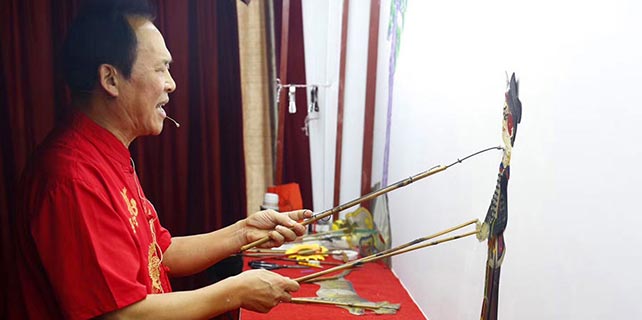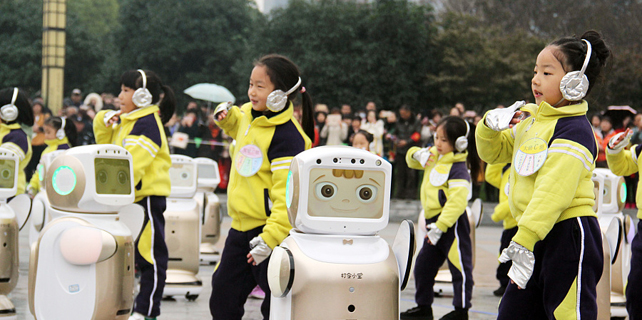Next chapter

Academic publisher Ian Bannerman remembers that on his first visit to China in 1992 he was astounded to see shelf after shelf of photocopied journals in university libraries. People at that time had no concept of copyright, he said.
These days, as managing director of journals at Taylor & Francis Group, a leading global publisher of academic books, Bannerman sells databases to hundreds of universities in China.
With more Chinese scientists' studies included in international journals, his job is "more about bringing China's research to the world".
Publishing, as an instrument of "soft power", is now at the forefront of the China-led Belt and Road Initiative to build a modern trade and infrastructure network that spans the ancient Silk Road routes.
According to the State Administration of Press, Publication, Radio, Film and Television, or SAPPRFT, China's trade volume of publishing copyrights has seen more than 20 percent annual growth during the past three years.
Imported books changed from mainly fiction and nonfiction titles from the West to titles from elsewhere, including Latin America and Africa, especially in the children's books category.
Exports grew significantly, from 5 percent of China's total new titles in 2014 to 15 percent last year.
"Book titles traded between China and countries involved in the Belt and Road increased from 2,700 to 5,000 during the same period," said Wu Shangzhi, vice-minister of the SAPPRFT, at the 24th Beijing International Book Fair, China's major publishing trade expo.
It is the world's second-biggest book fair in terms of participant numbers, after the Frankfurt Book Fair in Germany.
During the five-day event, from Aug 23 to 27, some 2,500 publishers from 89 countries and regions exhibited more than 300,000 books and signed 5,262 trade contracts, up 5 percent year-on-year. About 60 percent of the contracts were for exports, up 5.5 percent.
"Most of these exported books are about modern China's economic development, policies and entrepreneurship, as well as social changes in the past decade," Wu said.
Government-led projects still lead the way. For example, China has signed bilateral translation projects with 29 Belt and Road countries. Publishers from both sides are funded to translate each other's classic literature.
Currently, about 60 Russian literary titles and 30 Arabic titles have been sold in China.
State-owned publishers, such as the People's Literature Publishing House and The Commercial Press, are encouraged to copublish books with foreign partners. To date, 300 Chinese books have entered markets in more than 50 countries, with 200 more titles in the pipeline.
The more efficient way is to set up branches in overseas markets — which about 20 Chinese publishers have done — by building local distribution channels and marketing plans based on demand for original content.
Qi Dexiang, founder of Phoenix Tree Publishing, a Chicago-based subsidiary of Beijing Language and Culture University Press, led the language education textbook publisher to the United States in 2011, and broke even in three years.
It is the first Chinese university publisher to open an overseas office. And making that move involved a long process of evaluation.
"We found that the number of foreign students coming to China has stagnated at about half a million for a few years and it seems it will remain that way for some time," Qi said.
Meanwhile, the number of overseas students learning Chinese is growing very fast. In the US alone, there are 300,000 students registered in online Chinese classes conducted by the Confucius Institute, Qi said.
The Confucius Institute, affiliated with China's Ministry of Education, promotes Chinese language and culture across the world.
With the aim of targeting overseas students who are keen to learn Chinese, Qi and his team — who are partly Chinese with the rest hired locally — lobbied US middle schools and high schools.
Finally, their books received the green light to enter the US national education system.
"We have a strong backlist (older books still in print) back home of more than 3,000 textbooks designed for foreign students." Only a little rewriting is required to make them suitable for the US market, Qi said.
Now, Phoenix Tree's books are sold through Amazon and Barnes & Noble into 45 states, 200 universities and more than 1,000 high schools, middle schools and primary schools across the US.
"I would say it's win-win — the students get better textbooks, our authors get double royalties from two markets," Qi explained.
There are three major ways for Chinese publishers to go global, and setting up an overseas office is one of these strategies, according to Richard Charkin, former president of the International Publishers Association (IPA), at the Beijing International Book Fair.
"It's like the British university presses did in the 20th century — to set up branches across the world — and it was very successful."
However, this strategy has its downsides, Charkin noted. "It's very slow, and can fail altogether."
The second way is by acquisition, which is quick, simple and strategic, but very expensive.
Then there is the third way — a partnership, which allows the Chinese companies to understand the complexity of each market.
"A mix of all three would be the best result," Charkin said.
He emphasized the importance of publishing books in English. The big European players — such as Hachette Livre from France, Grupo Planeta from Spain, Holtzbrinck Publishing from Germany — all took the opportunity to become international brands.
"Chinese publishers should learn from these experiences," he noted.
In 2015, China was elected as an IPA member. It helped the global publishing community and China understand each other better.
Charkin, who is also the executive director of Bloomsbury Publishing, the publisher of the Harry Potter books series, said the British company will launch a new imprint, Bloomsbury China, in 2018. It will publish the works of Tang Xianzu, a great playwright who lived during the Yuan Dynasty (1271-1368).
Bloomsbury is not the first international publisher to tap the Chinese market.
Penguin Random House entered China in 1995, doing both local publishing and translating Chinese literature, from the modern classics of Lu Xun and Lao She, to contemporary writers such as Mo Yan and Sheng Keyi.
In 2010, Hachette Livre formed a joint venture with China's Phoenix Publishing & Media Group, with the focus on publishing children's books.
During the recent Beijing book fair, United Kingdom-based Usborne signed a partnership to publish 30 titles with China's Jieli Publishing House, an industry leader in children's books.
The children's books segment has been the main driver of the Chinese market in the past few years, recording annual growth of around 30 percent.
China has become the world's second-biggest book market, with total sales reaching 83.1 billion yuan ($12.7 billion) last year, according to a report by German Book Office Beijing, a brand name of the Frankfurt Book Fair's media consultancy, Creative Publishing Consulting.
But the US, which dominates the global publishing industry, is double the size of the Chinese market, with total sales of $25 billion last year.
Eric Abrahamsen, founder of the Paper Republic, a Beijing-based company devoted to translating Chinese literature and introducing it to the West, finds it very hard to persuade foreign publishers to buy Chinese books. A major problem is that few publishers recognize good writers in China, he said.
"(Foreign publishers) think it is risky to buy Chinese books because, compared with domestic books, they have to pay extra money for translation and spend a longer time to make the book," Abrahamsen said.
As an American who has lived in China for 16 years, Abrahamsen translated Wang Xiaofang's The Civil Servant's Notebook and a novella collection of Wang Xiaobo, the first Chinese author whose work he fell in love with.
Abrahamsen's active promotions of Chinese literature include Northern Girls by Sheng Keyi, The Invisibility Cloak by Ge Fei and Jia Pingwa's Happy Dreams, which was published by Amazon as part of this year's Beijing book fair.
Danny Wang, director of digital content acquisition at Amazon China, said Happy Dreams will be sold worldwide through Amazon's websites. The title is the first Chinese book to be included in the Kindle First program, which gives members the opportunity to download an editors' pick a month before the official publication date.
Wang said the online bookseller has been trying to provide a onestop service for Chinese publishers in recent years.
"If you want to be serious about China, either buying or selling, it's essential to visit (the country)," said Jessica Kingsley, founder of UK-based health imprint Singing Dragon, which specializes in Chinese medicine books.
"The market is changing so fast, it really does help to see it firsthand," Kingsley said.
















